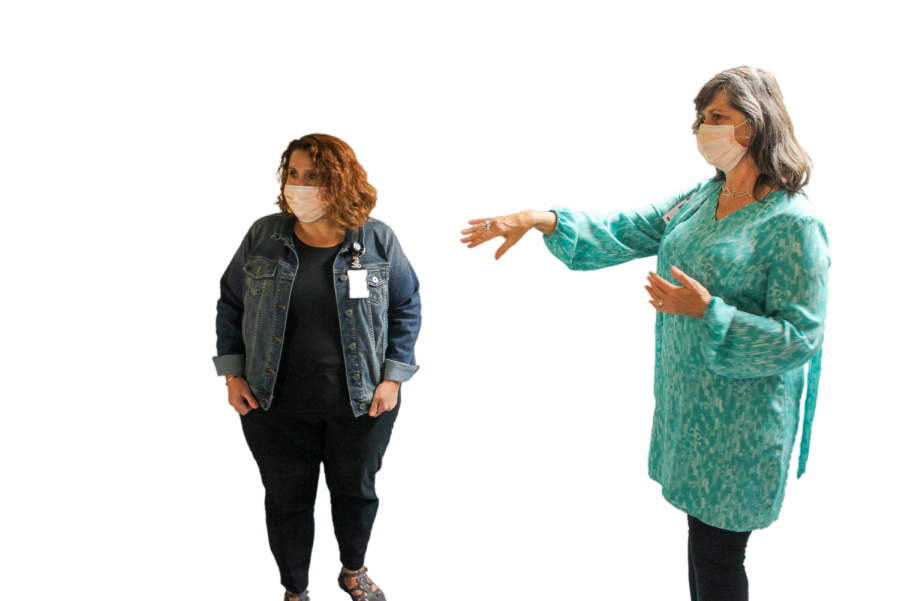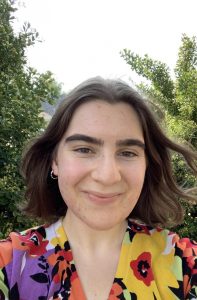Art Therapy: Talking Mental Health with the U’s Professionals
September 29, 2021
The return to in-person classes this fall semester poses the question of how to safely and effectively transition back into public spaces, and cope with the accompanying stress of doing so.
As the pandemic’s effects on students’ well-being — both physical and mental — persist, the pressure to
perform at school combined with the pressure to stay protected against the virus can be a source of tremendous anxiety.
To learn more about easing some of that anxiety, we spoke with artists and art therapy practitioners about the role of art in mental health, integration of arts in medicine and their work in the field.
Process Over Product
Kathryn Wingard, a licensed art therapist with an MFA in ceramics from the University of Utah, helped contextualize the difference between therapeutic forms of art — something we all do, and often innately — and the practice of clinical art therapy.
Practicing art as a hobby or profession maintains a focus on learning new skills or completing a project, whereas sessions with a clinical art therapist set a goal of healing without focusing on an end-product. “It’s like talk therapy with a different medium,” Wingard said.
The art medium, painting, sculpture, music, dance or even forum theatre, acts as what Wingard describes as a “safe third,” providing a meeting space or common ground for client and therapist to connect. Each session doesn’t culminate in a pretty picture, literally or figuratively, but is a way of establishing a safe and supportive space.
“It’s one of the only disciplines or experiences in the hospital where we don’t go in to fix something,” says Saundra Shanti, a chaplain at University of Utah Health.
With undergraduate experience in the arts and a graduate degree in theology as well as arts in medicine from the University of Florida — Shanti’s thesis was centered on integrating art and ritual into spiritual care — she understands how art’s role in clinical settings doesn’t always include an end goal, but is a way of opening up conversation.
“We go to connect with people, to be with people, and that allows a spaciousness or an openness. What I like about that too is it allows the patient to have power and control.”
One of Shanti’s colleagues and collaborators is Shelley White, the manager of the Wiggins Wellness and Integrative Health Center at the Huntsman Cancer Institute, where she oversees wellness service, including creative art therapies with various Artists-in-Residences and a team of music therapists who focus on community and individual interventions with cancer patients.
As a Ph.D. candidate in the School of Nursing with a social work background, White takes the approach of a researcher in conversation, citing studies focused on integrating procedural medicine and the arts.
One of the licensed music therapists White oversees is Heather Fellows, who spoke on her training in identifying the needs of the patients. “We are here to help with physical needs, as well as the emotional.”
Her work is largely customized to the patient receiving the therapy. Allowing patients to gravitate towards what they identify with has benefits in both perceived and recorded relaxation, provides patients distraction from physical pain, and is often accompanied with an emotional release. “It’s our job to hold that emotional space for whatever’s coming forward … and leave them with something to take with them throughout the day,” Fellows said.
Integration of Art and Medicine
Evidence-based practice and research studies have helped draw further attention to the benefits of integrating arts and medicine for mental health, supporting its practice in healthcare.
“You can merge the medical intervention with the surgical intervention … You could take biological markers and look at blood or salivary cortisol [during art-making] and see what kinds of inflammatory biomarker changes are taking place,” White says. The research supporting arts’ benefit on mental health is exciting and rich with possibilities for the future, though it remains important to differentiate between clinical art therapy and the use of art as a therapeutic practice.
As both artist and art therapist, Wingard understands how the two roles operate differently. When teaching an art class, she operates as an artist, not specifically bound by clinical procedures and requirements. With patients in her private practice, she embodies the role of therapist, a role which requires more professional training than a therapeutic art practitioner.
The therapist’s role in a clinical setting is to carve out a space that allows the patient to feel safe enough to engage in art-making. For some patients, coming into the art therapy environment can bring up negative emotions associated with art-making. Clinical tools are used in order to best tailor therapy sessions to an individual’s specific needs — something that cannot be done in a communal arts environment or one-time activity.
With that said, it is still true that both clinical art therapy and therapeutic art practice have been shown to be beneficial tools for mental health improvement.
The Future is Creative
The integral role of the arts in health is becoming clearer, but what does that mean for the future of arts in medicine as a field? Shanti expressed frustration with how therapeutic art is classified by the Western model of medicine, which is heavily based in scientific methodology, in quantitative evidence, while often ignoring other qualitative measures of health.
“The idea that [art and medicine] are separate from each other is a modern biomedical construct. If you go back further in human history, the arts are always a part of healing,” Shanti explained. “There’s dancing, there’s ritual, there’s drumming, there’s mask-making. All of that is going on, and has been throughout human history, when we are trying to heal people and be well.”
Susan Sample, a professor in the School of Medicine in the Division of Medical Ethics and Humanities who serves as a Writer-In-Residence at the Huntsman Cancer Institute, spoke again to the faulty models we have for understanding the intersection of arts and humanities and health and medicine.
“It is somewhat of an artificial divide … Medicine is a science, but medicine is an applied science — applied to human beings. That changes everything. The humanities are critical in treating patients and developing a patient-provider relationship.”
Where medicine often accounts for the mind and body acting as separate entities, the liberal arts allow for a more cohesive and holistic perspective on wellbeing that joins the two.
As a poet, Susan works with patients in accessing the “therapeutic arc” of creative expression. In her mind, writing haikus or following a narrative train of thought gives patients, and humans, “that safe space to address things that they couldn’t express otherwise.”
Expressive writing allows patients to step back into a place of authority and compassion for their journey, whatever illness or ailment.
Breaking Boundaries
Art therapists and therapeutic art practitioners share the experience of trying to help individuals overcome self-limiting beliefs about art-making. By its nature, art puts us in vulnerable places, and if we’ve been told throughout our lives that we “aren’t a singer” or “can’t paint” or are unable to create art if we aren’t “a professional,” our limitations can stand in the way of the arts’ benefits.
Shanti and White echoed this sentiment. “Humans are creative!” said Shaunti. “The sense of professionalism can be harmful,” White added. Whatever boundaries — whether internally or externally imposed — keeping us from innate creative expression are not conducive to our growth and healing.
“You know, COVID-19 has made us all patients in a way,” Sample says. “We’ve all undergone a shared trauma, however individual and however intense. A hope to return to the before is unattainable.” She adds, “A diagnosis changes what you thought you knew … All you can do is gain wisdom along the way that will help you heal.”
As for individually-held art practices, White told us that she listens to music and keeps a gratitude journal. “Besides, it’s more important who you are than what you do,” added Shanti.
In addition to playing and singing, Fellows shared that she doodles and works as a “costume momma” for school plays. Sample started a podcast during summer 2020 that included mindfulness snippets and poetry from BIPOC artists — her advice on engaging in art practice was to simply “coax the creation.”
Wingard left us with a piece of prescriptive advice. “Allow yourself 5-15 minutes to just play, non-judgmentally. Engaging in creative activity can provide a sense of mindfulness, where you allow the body to be and rest.”
In the face of anxiety, stress, and whatever emotion is weighing on us in the next semester, every practitioner recommended engaging in something easy, something expressive, something possibly vulnerable that will fill your cup.
“That’s just self-care, right? We need to recover, and find ways to do so,” says Sample. We can take a few lessons from the expertise of art therapists and creatives of all mediums and, simply, create.
The arts as a therapeutic practice have been researched and found to be beneficial for all people, but they are not a replacement and should not be confused with clinical art therapy. If you or anyone you know is struggling and interested in art therapy, reach out for professional help. For help locating an art therapist, visit the American Art Therapy Association for more information.










Kathy Tracy • Oct 13, 2021 at 6:47 am
May I repost this on my Grandma’s FB page?
Elizabeth “Grandma” Layton
Thank you! I think our readers would enjoy it!